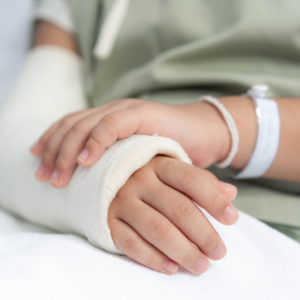Common Hand and Wrist Injuries
Not many of us realize how much a hand injury can affect our our daily activities and everyday life. A hand or wrist injury, especially a  severe one, can cause the victim to lose time at work, need surgical treatment, have extraordinarily high medical expenses, and experience pain for the rest of their lives. Hand and wrist injuries, even seemingly small injuries (a dislocated finger, mild sprains, nerve injuries, ligament tears, wrist strains, etc.) need effective treatment so they don’t haunt you for the rest of your life.
severe one, can cause the victim to lose time at work, need surgical treatment, have extraordinarily high medical expenses, and experience pain for the rest of their lives. Hand and wrist injuries, even seemingly small injuries (a dislocated finger, mild sprains, nerve injuries, ligament tears, wrist strains, etc.) need effective treatment so they don’t haunt you for the rest of your life.
If your hand was injured in an accident caused by negligence, reach out to the Munley Law personal injury attorneys as soon as possible. We will work to recover compensation for medical bills, missed days of work, and ongoing medical care you need to fully recover. We offer a free consultation to new clients where we will assess your claim and lay out all your legal options.
Common Types of Hand & Wrist Injuries
Hand and wrist pain can be the result of strains, sprains, stress fractures, and breaks. The most common injuries to wrists and hands include:
Broken Bones
Your wrist and hands are made up of several bones, including carpal bones, metacarpals, and phalanges. A broken hand or wrist is a break or a crack in one or more of those bones. Severe breaks may require surgery to fix the broken bones.
A broken wrist or hand will cause severe pain that may worsen when you grip or squeeze. Swelling, bruising, stiffness, and numbness may all be signs of one or more wrist fractures or broken bones in your hand. If not treated timely and properly, the injured victim may experience ongoing stiffness and pain. Broken bones that extend to your wrist joint can cause arthritis, while other breaks may cause nerve and blood vessel damage.
Strains and Sprains
Ligaments are tissue that connect your bones, joints and organs. A sprain occurs when one of those ligaments is injured. The injured person experiences pain, swelling, and bruising. Most strains and sprains are minor and can be treated at home with over-the-counter medication, ice, and rest. However, a more severe injury occurs when the ligament is torn. If left untreated, a torn ligament may lead to complications like bone fractures, tendon inflammation, tendon injuries, and nerve damage.
Trigger Finger
According to the Mayo Clinic, trigger finger occurs when the tendon that controls the finger can’t glide smoothly in the sheath that surrounds it. It makes the finger get stuck in a bent position, then may straighten suddenly with a snap. The most affected fingers are usually the ring finger and the thumb, but trigger finger can affect any finger on the hand. Victims will experience finger stiffness, a popping or clicking sensation, tenderness at the base of the finger, and a locked finger in a bent position.
Amputations
An amputation is the complete loss or removal of a body part, including fingers, toes, hands, feet, legs, and/or arms. Amputations may be medically necessary following a catastrophic car accident, workplace injury, or construction accident. Amputation victims often experience severe physical pain and emotional distress.
Carpal Tunnel
Carpal Tunnel Syndrome is a common condition where the median nerve, which runs from the forearm into the palm of the hand, becomes pressed or squeezed at the wrist. The median nerve controls the movement of the thumb and first three fingers. When the nerve is squeezed, it becomes irritated, which is progressively painful.
Carpal tunnel syndrome can be caused by several different types of work including data entry, assembly line work, computer work, sewing, and even agriculture work. Carpal tunnel can also be caused by trauma to the hand or wrist in car accidents, slip and fall accidents, and other workplace accidents.
Burns
When the skin on your hand or wrist comes in contact with something hot, the cells in the skin become damaged and die. There are four degrees of hand and wrist burns one can suffer. They are:
- 1st degree burns: These burns are superficial and may leave a red mark on the hand or wrist.
- 2nd degree burns: These burns leave partial thickness skin damage and make the skin blister.
- 3rd degree burns: These burns leave full thickness skin damage. The skin becomes white and leathery.
- 4th degree burns: These burns leave damage to deeper structures beneath the skin like tendons, joints, and even bone.
 Causes of Hand and Wrist Injuries
Causes of Hand and Wrist Injuries
Hand and wrist injuries can result from various causes, such as:
Auto Accidents
Car accident victims often suffer accident-related traumas, such as upper extremity injuries, including injuries to the hands and wrists. A sprained wrist, wrist fracture, or break may occur from the blunt force of hitting the steering wheel, the dashboard, or other objects during the crash. If the hand or wrist is twisted or bent in the course of the collision, it may become dislocated. One of the most common injuries in an auto accident are strains and sprains from the forceful stop or impact of the collision.
Repetitive Motion on the Job
Repetitive motions on the job (computer typing, working with machinery, etc.) put a constant strain and stress on the hands and wrists. When a motion is repeated for several hours per day, it can lead to cumulative traumatic injuries like carpal tunnel syndrome and tendonitis. Exposure to vibration from tools and machinery (power tools, construction equipment, etc.) and also contribute to hand and wrist injuries on the job. Additionally, if the worker fails to properly rest the injured hand or wrist, it can increase the risk of more severe and long-term injury.
Falls
Falls are one of the most common sources of traumatic injury in the United States. Hand and wrist injuries are prevalent in a slip and fall accident simply because most people try to break the fall with outstretched hands. When that happens, fall victims (especially elderly victims) are likely to fracture or break bones, dislocate bones, or suffer soft tissue injuries.
Equipment and Machinery Malfunction
Heavy machinery and equipment, especially when it malfunctions, is extremely dangerous for the workers. Hands and wrists are known to be crushed by malfunctioning equipment leading to fractures, breaks, and amputations. Sharp blades cause cuts and lacerations to the hands, while contact with malfunctioning electrical equipment can result in severe burns and nerve damage.
When to Seek Legal Help for a Hand or Wrist Injury
The key to any personal injury claim is negligence. If your hand or wrist injury was caused by someone else’s negligence, you are entitled to compensation. The Munley Law hand injury lawyers will file the paperwork, conduct a thorough investigation, gather evidence, devise a winning legal strategy, and help you pursue fair compensation for your losses (both economic and non-economic).
While we can’t change what happened to you, we can certainly help you move forward with maximum compensation and a sense of justice. Call today for your free consultation with an experienced personal injury lawyer who has won millions for past clients. Call today to get the process started.
Posted in Personal Injury.
Tagged Claim Loss Motion Negligence Slip and Fall









